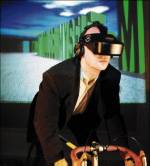

Space

ASTRONAUTS travelling deep into space will be able to relax by using virtual reality to visit family and friends back home. Images of favourite places and people on Earth will be beamed directly onto an astronaut's eyes to combat boredom.
Nasa is closely following a group of researchers at Virginia Tech who are developing the system. The American space agency believes that, if it works, it could help alleviate the isolation astronauts feel when everyday sights and sounds are left behind on Earth.
According to Dr Dwight Holland of the University of Virginia School of Medicine, virtual-reality technology is available now that can easily be built into long space missions.
It could be used in unexpected ways. Exercise, for example, is vital to stop bone and muscle deteriorating in space but astronauts are reluctant to do the boring and repetitive routines to which they are limited by the cramped conditions of a spacecraft.
"Astronauts report problems with motivation for sustaining intense exercises to prevent bone and muscle problems," says Holland. "Lightweight virtual-display devices could be used during exercise to generate a variety of scenes to overcome this boredom."
Stress is another problem that could be tackled with virtual reality. It could allow astronauts to visit home, take a walk in the park or go to a favourite cinema to relieve boredom.
It could also be used by a homesick astronaut to mingle with family and friends. By using mixed reality techniques an astronaut could appear to be walking with his family in a park or sitting in a favourite room.
Virtual reality will also mean that instead of watching a film alone in the capsule, the astronaut will be given the sensation of sitting with friends in a cinema.
Virtual reality will also play a role in overcoming some of the orientation problems caused by changes in gravity. These can result in dizziness and nausea.
Holland and his colleagues also point out that virtual reality will have a role in the operation of the craft and in preventing mistakes. They say that a near disaster aboard Mir, when a craft had difficulty in docking and hit the space station, could have been averted if the inexperienced crew had practised the manoeuvre with a virtual-reality headset.
"When a part of the spacecraft or space station needs repairing, the correct procedure could be uploaded to the vehicle from the ground and carried out, possibly with virtual-reality headsets as an aid during the repair," says Holland, who is reporting on some of the problems in space at the annual conference of the Aerospace Medical Association.
Nasa is tackling some of these health problems with a Telemedicine Instrument Pack, which is in the final stage of evaluation and testing at the Johnson Space Center. It will allow doctors on Earth to deal with problems encountered on a mission.
The pack will include eye, ear, nose, throat and skin imaging, as well as heart, lung and blood oxygen monitoring and a video camera surveillance system. It is portable enough for crew to wear, so they can be monitored while carrying out their tasks.
According to Holland and Dr Woodrow Barfield, a colleague, about 20 health effects have been identified in astronauts on long space flights. The heart shrinks, blood pressure drops and a shift in the balance of body fluids results in puffiness of the face. It is also thought that the immune system is partly depressed, that kidney stones begin to form and that bone loses its salt.
The researchers claim that the experiences of astronauts on Skylab, Salyut, Mir and on other long space missions have shown that virtual reality and telemedicine will have an important role in future space operations.
Some basic types of biotelemetry, including checks on heart rates and blood pressure, have been carried out since 1961 when Alan Shepard became the first American in space. The systems now being developed are far more advanced and deal with a range of new issues.
Nasa is not alone in thinking virtual reality could liven up exercise sessions. British and German researchers are working on a system that uses it to make exercising on a bicycle machine less of a chore. Software is being used to build three virtual cities - Amsterdam, Manhattan and Karlsruhe in Germany. These will be entered through the Internet. Once the area is downloaded, the user will be free to cycle through its streets and take in the sights.
There is also a social dimension. Several users can log on at the same time and take the same tour of the city. While on their way they can also say hello to other cyclists who have logged on and are making their own tours.
The project has received funding from the European Union so it can be
developed to a stage where it could be commercially viable. The idea came
from the Centre for Art and Media Technology in Karlsruhe. It is being
implemented by virtual-reality software developed by experts, including
Dr Alan Murta, at the computer science department of Manchester University.